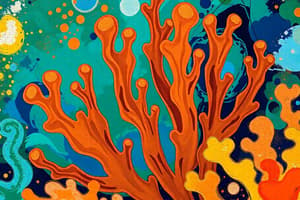Podcast
Questions and Answers
What type of pigments do brown algae contain?
What type of pigments do brown algae contain?
- Chlorophyll b, carotenoids, and flavonoids
- Chlorophyll a, c, and anthocyanins
- Chlorophyll a, c, carotenoids, and xanthophylls (correct)
- Only chlorophyll a and carotenoids
Which of the following forms of reproduction can brown algae exhibit?
Which of the following forms of reproduction can brown algae exhibit?
- Only vegetative reproduction
- Only asexual reproduction
- Asexual and various forms of sexual reproduction (correct)
- Only sexual reproduction
What is the primary carbohydrate stored in brown algae?
What is the primary carbohydrate stored in brown algae?
- Starch
- Laminarin or mannitol (correct)
- Sucrose
- Glycogen
What is the function of the holdfast in brown algae?
What is the function of the holdfast in brown algae?
Which pigment is primarily responsible for the brown coloration in brown algae?
Which pigment is primarily responsible for the brown coloration in brown algae?
How do brown algae primarily reproduce vegetatively?
How do brown algae primarily reproduce vegetatively?
In which structure does the union of gametes occur in oogamous species of brown algae?
In which structure does the union of gametes occur in oogamous species of brown algae?
What is the shape and structural characteristic of brown algae's asexual zoospores?
What is the shape and structural characteristic of brown algae's asexual zoospores?
Which of the following genera is NOT commonly associated with brown algae?
Which of the following genera is NOT commonly associated with brown algae?
Flashcards are hidden until you start studying
Study Notes
Characteristics of Phaeophyceae (Brown Algae)
- Primarily found in marine habitats.
- Exhibit a wide size range; simple forms (e.g., Ectocarpus) to massive kelps up to 100 meters tall.
- Contain chlorophyll a, c, carotenoids, and xanthophylls.
- Color varies from olive green to shades of brown, influenced by fucoxanthin content.
Structure and Storage
- Food storage as complex carbohydrates, primarily in forms of laminarin or mannitol.
- Cell walls are made of cellulose, often covered with a gelatinous layer of algin.
- Protoplasts include plastids, a central vacuole, and a nucleus.
Plant Body Composition
- Typically anchored to the substrate by a holdfast.
- Composed of a stipe (stalk) and fronds (leaf-like photosynthetic organs).
Reproduction
- Vegetative reproduction occurs through fragmentation.
- Asexual reproduction involves biflagellate zoospores; these are pear-shaped with two unequal, laterally attached flagella.
- Sexual reproduction can be isogamous, anisogamous, or oogamous.
- Gametes are pyriform, also with two laterally attached flagella; fertilization may occur in water or within an oogonium.
Common Genera
- Representative forms include Ectocarpus, Dictyota, Laminaria, Sargassum, and Fucus.
Studying That Suits You
Use AI to generate personalized quizzes and flashcards to suit your learning preferences.



